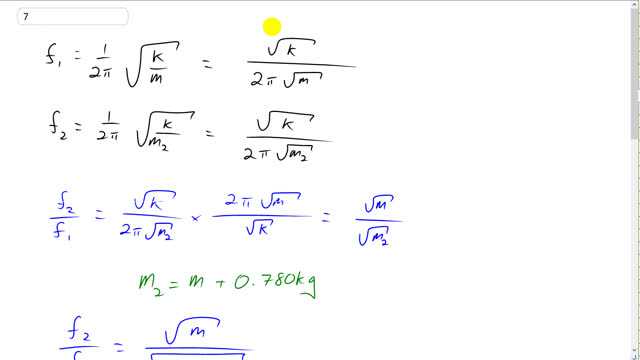
A mass at the end of a spring oscillates with a frequency of 0.83 Hz. When an additional 780-g mass is added to , the frequency is 0.60 Hz. What is the value of ?

In order to watch this solution you need to have a subscription.
This is Giancoli Answers with Mr. Dychko. The frequency of oscillation of this mass and a spring in the first case is going to be 1 over 2π times the square root of the spring constant, divided by the mass, m. And I'm gonna rewrite this as a single fraction with a square root k over 2π times square root m on the bottom it's exactly the same, but when I do it this way it's gonna make more sense when I divide f2 by f1 that you can take f2 which is going to be 1 over 2π times... Well, actually I'm gonna, think of it this way, square root k over 2π times square root m2. We're gonna multiply by the reciprocal of f1 instead of dividing by this fraction f1. It's easier to multiply by its reciprocal. So, having it written as a single fraction makes it easier to see how it flips. So, the 2π square root m goes on top and then the square root k goes in the bottom and me multiply by the reciprocal of f1. So, square root k's cancel and the 2π's cancel and we're left with square root m over square root m2. And m2 we're told is 780 grams more than m, 0.78 zero kilograms more. And so f2 over f1 is square root m over square root m plus 0.78 kilograms. And square both sides to get rid of the square root signs there, and you get f2 squared over f1 squared is m over m plus 0.78. And then get rid of the fractions by multiplying by both denominators. So, multiply both sides by f1 squared and then also multiply by m plus 0.78. And on the right hand side you're left with just f1 squared because the m plus 0.78 cancels, times by m, of course, though, f1 squared times m on the right side. And on the left side the f1 squared cancels and you have f2 squared multiplied by both parts in the bracket. So, we'll have 2 squared times m and f2 squared times 0.78. And then collect the m terms together because that's what we're trying to solve for. So, bring this to the right hand side so that makes m a common factor that you can factor out from the m f1 squared minus m f2 squared. So, we have m multiplied by f1 squared minus f2 squared. And I've also switched the sides around here too so that the m term is in the left. And that equals f2 squared times 0.78. And then divide both sides by this bracket and you get the mass is second frequency squared times 0.78 divided by the difference in the squares of the frequencies. So, we have 0.6 hertz squared times 0.78 kilograms divided by 0.83 hertz squared minus 0.6 hertz squared. And that gives 0.85 kilograms was the original mass.
I don't understand how you got the M by itself can you pleas review this or post back. Thank you.
never mind